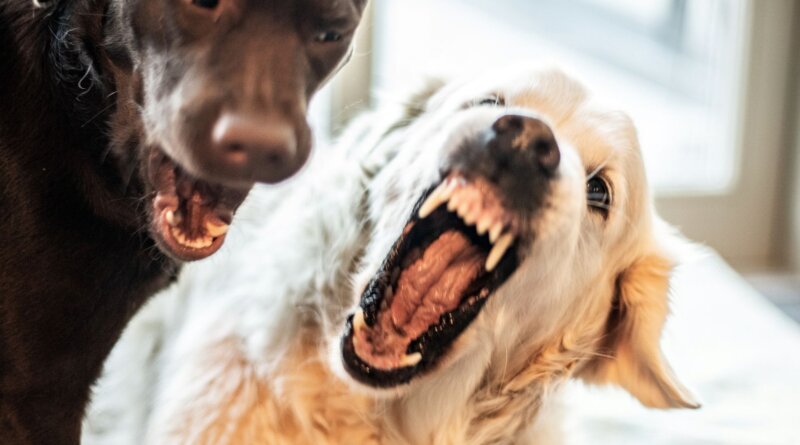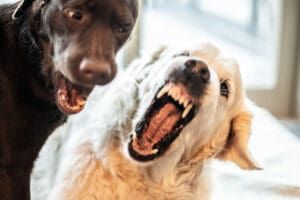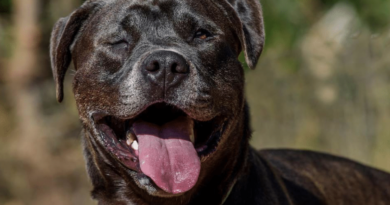Why is my Dog Aggressive with Other Dogs
Of all the canine behaviors that humans find upsetting – or even traumatic – aggression is usually the one that elicits the most concern. Canine aggression can be shocking in its speed, unpredictability, and violence, and it’s not much less disturbing when your dog is aggressive with other dogs rather than at humans.
Dog-aggressive dogs can be discriminating in their choice of targets. A dog who aggresses toward other dogs doesn’t necessarily try to fight with all other dogs. Five of the most common “flavors” of aggression toward other dogs are:
- Aggression toward other dogs in the family.
- Aggression toward visiting dogs.
- Aggression toward dogs when on leash in the outside world.
- Aggression when off leash and approached by dogs in the outside world.
- Random, inconsistent aggression toward other dogs in a variety of situations.
Of these five, the first four generally have a somewhat predictable pattern, which can help us manage and even prevent troubling outbursts of aggressive behavior. Sporadic, inconsistent episodes of aggression are more difficult to solve, and help from an experienced force-free behavior professional will likely be required.
WHEN DEALING WITH AGGRESSIVE DOG BEHAVIOR, KEEP THESE POINTS IN MIND
I do not label any dog an “aggressive dog.” Rather, I refer to them as “dogs with an aggressive behavior.” This recognizes that the dog has many good qualities and provides support for the humans who are often called upon to defend their “bad” dogs. Most of these dogs are fun and loving companions most of the time, which is why it’s so daunting when an otherwise wonderful dog exhibits this challenging behavior.
The quest to understand and improve the behavior of any dog who exhibits aggressive behaviors needs to start with a full medical workup, ideally with a veterinarian who specializes in pain evaluation in addition to a general practitioner.
Many medical conditions can cause anxiety and pain, which are both significant contributors to aggression. Trying to manage and modify aggression without identifying and treating medical contributors is akin to pushing a boulder uphill. A full medical evaluation often rules out or identifies any physical ailments that need to be treated.
Every dog is different, so each case of inter-dog aggression requires its own analysis and an individualized management and modification program, but there are commonalities in the above scenarios that are worth examining.
With that in mind, here’s how to deal with the five most common presentations of dog-dog aggression:
Dog Aggression With Other Dogs in the Family
This is perhaps the most difficult of the scenarios, since the dogs need to live together in the home, which can be very stressful for canines and humans alike.
In some cases, this aggression presents only indoors. Many of these dogs appear to be perfectly compatible playing together in the yard or at away-from-home venues. This suggests possible resource guarding of space, valued objects (such as the sofa), and/or humans – a common cause of intra-family aggression that is often easily managed. For more information about behaviors related to resource guarding, see Food Aggression in Dogs.
In-home aggression can also result when a dog is stressed about being trapped in a confined space and behaves defensively aggressive indoors but gets along with his canine roommates when outdoors. On the other hand, some dogs are just as likely to attack their canine siblings outdoors as indoors, which suggests a deeper-seated conflict.
Sometimes the wrong dog gets blamed for intra-family conflicts. Dog A is an exuberant player who overwhelms Dog B and ignores her “Please tone it down!” signals. Dog B, uncomfortable with the interaction, may be pushed into aggressing to get her message across to Dog A. Dog B gets blamed for the fight, when it’s really Dog A’s fault for not responding appropriately to Dog B’s “Please stop” signals. In this case, human intervention is necessary to interrupt the play before Dog B makes her own defensive statement.
Here are some tips for dealing with intra-family aggression:
- Observe the dogs to determine if there is persistent ongoing tension or if the dogs are calm and relaxed with each other when not in the trigger situation. Identify when and where you see tension between the dogs.
- Manage the potential combatants to avoid opportunities to practice the behavior and increase the intensity of emotions. If they are mostly calm and you can predict the trigger, the dogs can spend some time together. If there is constant tension, the conflict is unpredictable, and/or the triggers not identifiable, then you need total separation while you work to modify the behavior.
- Implement standard behavior management and modification protocols to change the dogs’ associations and behaviors with each other. My go-to protocol is usually counter conditioning and desensitization. See “Counter-Conditioning and Desensitization for Reducing Dog Reactivity,” available online at whole-dog-journal.com.
- Contact a qualified force-free behavior professional if you are not confident about handling this on your own, or if you are attempting to but not seeing good results. See “Find the Best Trainer for You and Your Dog,” WDJ June 2023.
Ultimately, if the dogs cannot learn to live peacefully together, it might be appropriate to rehome one of them, especially if there is a friend or family member who knows and loves the dog and will take her.
Dog Aggression Toward Canine Visitors
Many dogs see other dogs coming into their territory as intruders and threats. If your dog normally gets along well with others outside her home, you may be able to convince her that having canine visitors is a good thing. If not, your easiest solution is to not have other dogs come to your home.
Introduce your dog to his prospective visitor in a neutral territory – perhaps a neighbor’s fenced yard, or a secure space rented through SniffSpot.com (the “Airbnb” of private dog parks). Start with the dogs on leash at some distance from each other, and if they both look happy, drop the leashes and let them play. After a few minutes of appropriate play, remove their leashes and let them continue to play. For more information, see How to Safely Introduce Your Dog to Other Dogs.
When all is going well and the dogs are clearly being social with each other (not just tolerating or avoiding), do parallel walking (on leash) in the home-dog’s neighborhood. If you see signs of tension there, go slowly. Sit and chat somewhere comfortable, some distance from the dog’s home.
When the dogs are comfortable walking the neighborhood, do the same thing in the home-dog’s backyard (assuming a fenced yard). Walk and/or sit with the dogs until all is calm, and then remove leashes and let them play.
If a yard isn’t an option, take the dogs indoors on leash and manage their proximity to each other until the home-dog is clearly relaxed and comfortable with the visitor. Then let them interact off their leashes with close supervision until you are confident that they are OK together.
Aggression When Walking on Leash
When a dog is perfectly social and appropriate with others when off-leash, but aggressive when on-leash, there are couple of possible explanations. Being on leash interferes with your dog’s ability to interact normally and communicate with appropriate social signals.
If she’s aggressive toward other leashed dogs, she may have been allowed to greet other dogs on leash, or anytime she’s off leash, and now she gets aroused and frustrated if she isn’t immediately allowed to greet them as soon as she sees them. Or, she may be somewhat fearful of other dogs, though when she is off-leash she knows she can escape if necessary. When leashed, she realizes she’s trapped and can’t get away, so she puts on an aggressive display in an effort to keep the other dog(s) away from her.
To work with this behavior:
- Do not allow your dog to greet other dogs on leash. Ever. This can often prevent on-leash aggression from developing in the first place.
- Use counter conditioning and desensitization to change her association with other dogs so she doesn’t feel the need to protect herself, but rather sees the presence of other dogs as a predictor of yummy treats from you (chicken!)
- Use a variety of operant behaviors that she loves in the presence of other dogs as management tools and to move her brain from “worried” to “happy,” such as:
- Find It! (Drop a treat at your feet and tell her to “Find it!”)
- Walk Away. Teach your dog a cue for turning and moving away from things. See “Teach Your Dog to Just Walk Away,” WDJ September 2018.
- The 1-2-3 Pattern Game. This is where you count your steps “One! Two! Three!” as you walk with your dog and drop a treat on the ground by your foot every time you say “Three!”
- You can also just feed treats to manage your dog’s behavior as another dog passes by, until the other dog is far enough away that your dog will no longer react.
It’s a bigger challenge if your dog behaves with aggression when she is approached by a loose dog, because the approaching dog is unknown and unpredictable and because, again, your dog feels trapped on the leash and can’t communicate with appropriate social signals. There are several things you can do:
- Avoid walking your dog where there are likely to be loose dogs (based on past history of loose dogs!).
- Continually scan for potential “safe havens” when you are walking – places where you and your dog can escape to if necessary.
- Carry a dog-safe canine deterrent spray.
- Toss a generous handful of treats at the approaching dog and then do your “Walk Away.”
- Yell at the approaching dog and stomp your feet.
- Teach your dog a “Get behind me” cue so you are between her and the loose dog.
- Protect yourself and your dog with an umbrella or walking stick.
For more detail, see On Leash Aggression.
- Aggressive when off leash and approached by other dogs. This one is all your responsibility. If you know your dog is aggressive toward other dogs when she’s off leash, you simply cannot let her off leash anywhere that you might encounter other dogs. If you do want to modify this behavior, work with a qualified force-free behavior professional.
- Random, inconsistent aggression in various situations. This may be the most obvious case for the aforementioned behavior professional. To manage your dog properly, you must be able to recognize the underlying triggers of her aggression. Even if it seems random and unpredictable to you, an experienced professional may be able to identify contributors to your dog’s aggressive behavior.
RULES TO LIVE BY WHEN YOUR DOG IS DOG-AGGRESSIVE
Three things are vitally important to keep in mind when you are working with a dog with aggressive behaviors:
If you can predict it, you can prevent it. Watch your dog in every situation where other dogs are present and take immediate action to intervene if you see the slightest sign of tension or annoyance.
Employ management tools (gates, doors, tethers) and practices at all times. We can’t say this often enough: It is incumbent upon you, as the dog’s human, to manage her environment so she never has the opportunity to attack another dog. For some dogs, this means management for her lifetime. For others, it may mean until you have successfully addressed the behavior and she no longer offers to aggress toward other dogs.
Maintain realistic expectations. Lots of dogs don’t get along with all other dogs. It could be that the most realistic outcome is that your dog can develop a small circle of intimate canine friends but may never be allowed to encounter unfamiliar dogs. You might always have to keep toys picked up so your toy-guarding dog doesn’t launch at your other home-dog for glancing at her favorite stuffy. Maybe your dog can never be around another dog, period. All of those things are OK. You and your dog can still have a great life together without your dog having to interact with other dogs, as long as you are willing to do whatever is necessary to keep everyone safe.
It bears repeating that often with “random” aggression cases there can be an underlying medical condition that triggers the dog to aggress.





